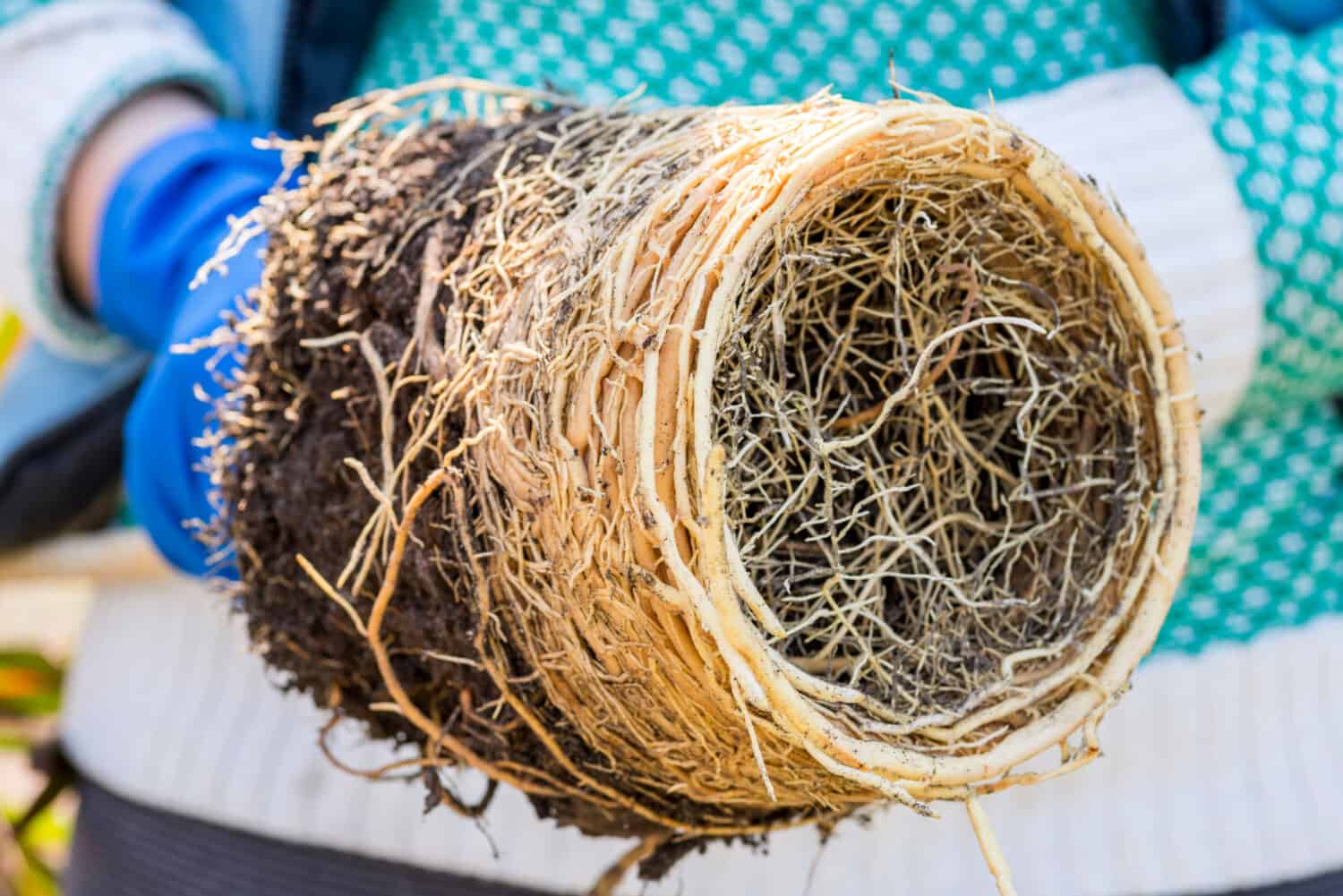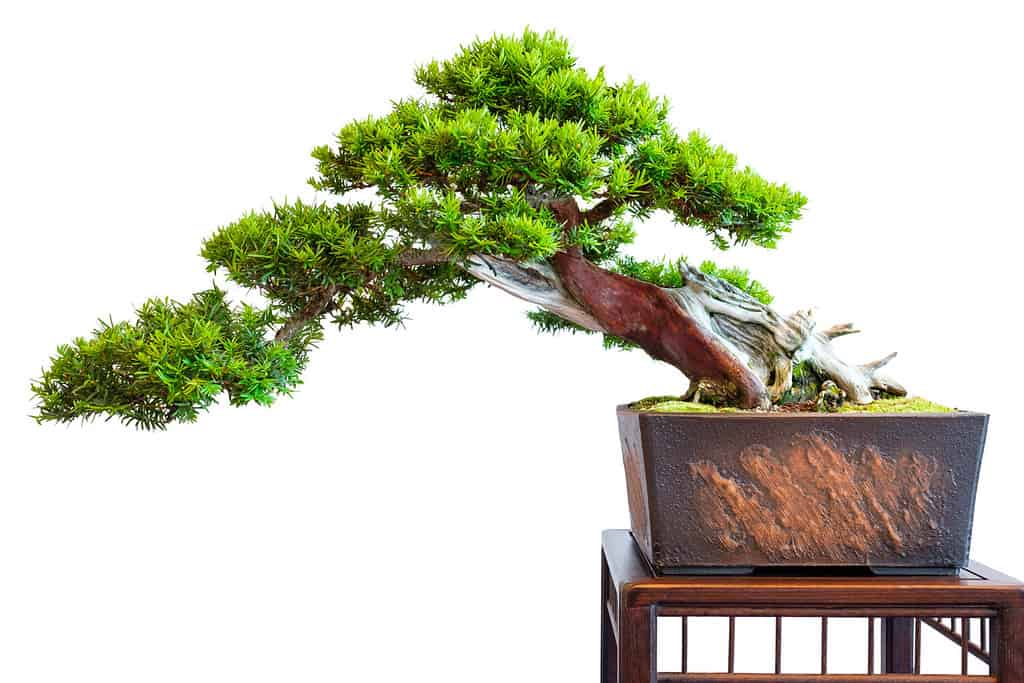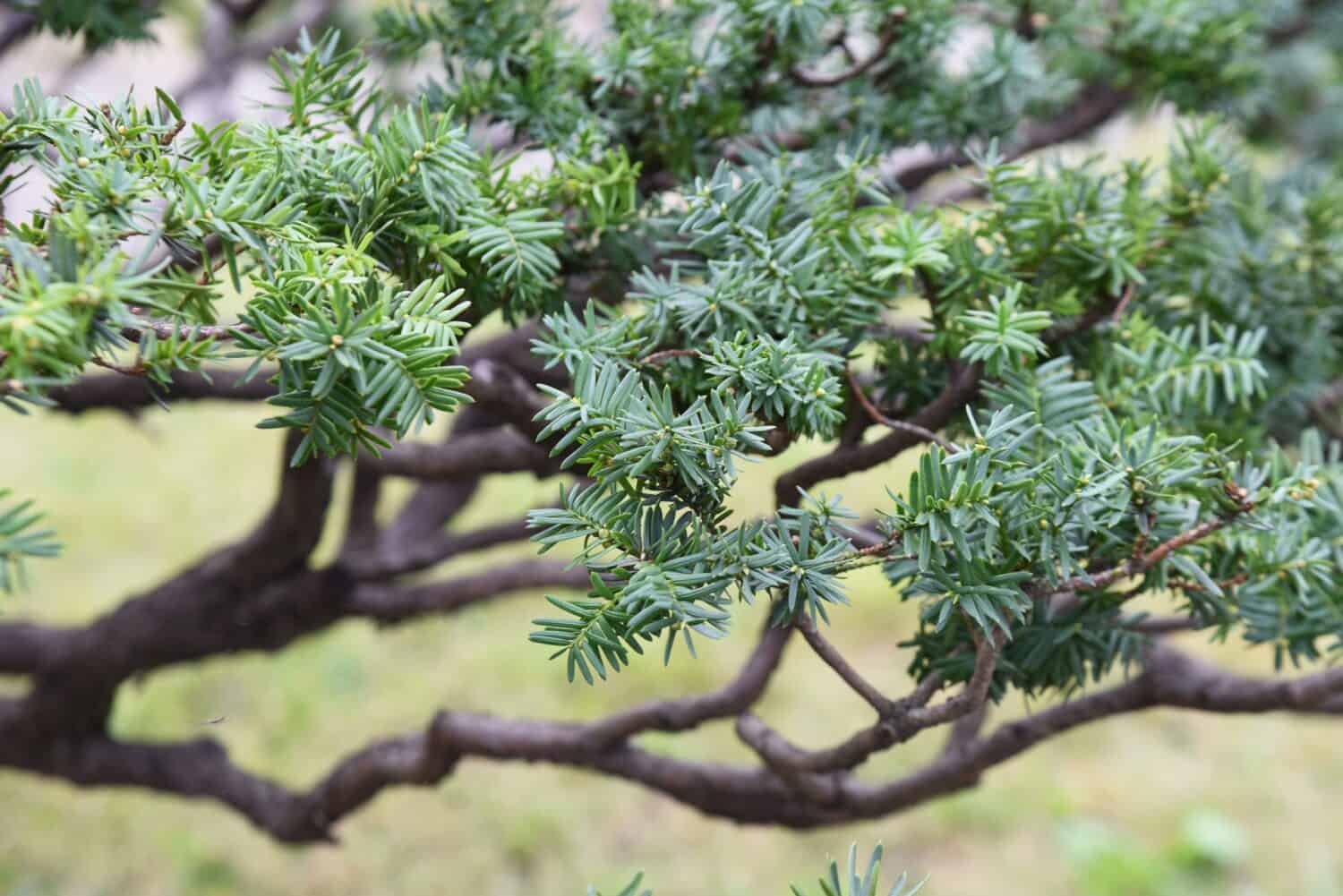While they are often used in landscaping, yews also make for excellent bonsai trees. Their resilient nature and strong wood make them well-suited for shaping and styling. Versatility in terms of lighting means that they can thrive both indoors and outdoors as well.
If you’re considering growing a yew tree for use in bonsai, the information below will give you a good foundation to build on.
| Botanical Name | Taxus sp. |
| Popular Species | European yew (Taxus baccata); Japanese yew (Taxus cuspidata); Pacific yew (Taxus brevifolia); Canadian yew (Taxus canadensis) |
| Water | Water only when the soil has begun to dry. The frequency will vary. |
| Sunlight | Does well in full sun or partial shade. |
| Soil Type | Standard bonsai mix |
| Indoor or Outdoor? | Both. Protect from frost and harsh, direct summer sunlight. |
| Beginner Friendly? | Yes, but very slow-growing. |
| Special Considerations | The entire plant, except for the fleshy red berry, contains toxic alkaloids (taxines). Seeds contained within the berries are also toxic. Ingestion of toxic parts of the plant can be fatal, even in small amounts. |
Common Species of Yew Bonsai
The most common species of yew trees used in bonsai are the European yew and the Japanese yew. These trees are slow-growing evergreens that produce flexible early wood and hard, dense latewood. Because of this, new growth is easy to shape but becomes less flexible with age.
While they are slow to grow, yews are hardy, long-lived, and pretty easy to take care of. Yews that are especially well cared for can live hundreds of years. While other species of yew can be used for bonsai, such as the Canadian yew and the smaller Pacific yew, we’ll talk about the two most popular species below.
European Yew Tree (Taxus baccata)
Also known as the English yew or the common yew, this species is a popular choice for use in bonsai. It responds well to pruning and propagates easily from seed or cutting. The tight clusters of deep green needle leaves are very attractive and well-suited for a variety of bonsai styles. Additionally, the European yew has a propensity for producing very full, densely branching growth in the right lighting.
These trees are dioecious, meaning that individuals of the species are sexually distinct and cannot usually self-fertilize. Females of the species produce prominent, red berry-like arils that each contain a single seed. These arils are the only parts of the tree that are not toxic. All other parts are severely toxic and ingestion of any of them necessitates emergency medical attention.

The European yew has a propensity for producing very full, densely branching growth in the right lighting.
©iStock.com/N/A
Japanese Yew Tree (Taxus cuspidata)
The Japanese yew, Taxus cuspidata, is similar to the European yew in its resiliency. Like the European yew, the Japanese yew responds well to pruning and produces flexible young growth that hardens with age. New growth can be trimmed back into the old growth and will ramify well as a result. Like the European yew, all parts of this tree, save for the aril flesh, are toxic.
These evergreen trees also respond well to more advanced deadwood sculpting techniques. Creating and bleaching a Jin, Shari, or Uro, which are different types of controlled wounds or bark removal, can create a gorgeous and striking contrast between the Japanese yew tree’s deadwood and its deep green foliage.

A Japanese yew,
Taxus cuspidata, featuring beautiful deadwood and dense foliage.
©Bernd Schmidt/Shutterstock.com
How to Care for Your Yew Bonsai
Yew trees are particularly hardy and forgiving to care for. If you follow the basic guidelines below and take care when pruning and performing maintenance, your yew tree should flourish for years to come.
Watering
Bear in mind that watering on a routine is not always the best practice. If you water too much or too frequently without first checking the soil, you could inadvertently waterlog your soil. This can lead to anaerobic soil conditions that encourage root rot.
You should water your yew bonsai only once the soil begins to dry out. Before watering, use the tip of your finger or a narrow tool to make a small hole about a half-inch deep into the soil. If the soil at the bottom of the hole is dry, give your tree a good soak. As you become more accustomed to the rate at which your soil dries out, knowing when to water will become second nature.
Sunlight
Yew trees are versatile when it comes to light requirements. They grow well in full sunlight as well as partial shade. Wherever your place your tree, bear in mind that it is evergreen and will require good sunlight year-round.
If you’re keeping your yew bonsai indoors, you’ll want to place it near a window that receives plenty of light throughout the day. Bright, indirect sunlight is usually plenty. Although your tree can tolerate shading, it will produce less foliage in shady conditions. If you live in an area that experiences cold winters, be sure that your tree’s window is not drafty. Cold air can harm your plant’s roots and foliage, even indoors.
When placing your bonsai outdoors, be sure to shelter it from intense afternoon sunlight. This is especially important in the summer as high temperatures and direct sun can quickly dry out your tree’s soil and damage its foliage. Ideally, your plant will receive sunlight in the morning and evening when the sun is lower in the sky. If your area experiences cold winters, you will need to bring your tree indoors. Without the insulation of the ground, potted plants are more susceptible to damage from the cold.
Soil Conditions
A standard bonsai soil mix of baked clay, pumice, and lava rock in an even ratio is perfectly acceptable for this tree species. However you mix your soil, ensure that it drains well.
If your area experiences particularly hot or dry conditions, you may opt to increase the amount of clay, such as Akadama, in your soil mixture. This will increase the capacity of your tree’s soil to retain water. If your soil does not drain well enough at a standard ratio, increase the amount of lava rock and pumice in the mix.
Repotting
Every bonsai tree eventually needs to be repotted. Even though they are slow growers, yew trees are no exception. You will usually want to move your yew tree to a new, larger pot every three or four years. This timeframe is only an estimate, however, and may not always be accurate as growing conditions can differ greatly. You must check your plant to be sure that it needs to be repotted. To do this, carefully lift your tree from its pot in the spring. If the roots are visible in large numbers or are beginning to form a dense, tangled mass around the edge of the container, it is time to repot your tree.

Plants that become pot-bound will have a difficult time gathering water and nutrients as their root mass displaces and loses contact with soil. If your bonsai shows a mass of roots around the edges of the container, it’s time to repot.
©Andrii Spy_k/Shutterstock.com
Toxicity and Placement Considerations
You should take special care when choosing where to place your yew bonsai tree as all parts of the plant, except for the flesh of its red berry-like arils, are toxic. Ingestion of any toxic part of the plant, even in small quantities, can prove fatal. Even a small number of needle leaves contain enough toxic taxine alkaloids to kill a human. Be certain that your plant is out of reach of children and pets. If ingestion of toxic parts occurs, seek medical attention immediately.

All parts of the yew tree, except for the flesh of its red arils (pictured above), are extremely toxic if ingested. Exercise caution when choosing where to keep your yew bonsai.
©iStock.com/Leo Malsam
How to Shape Your Yew Bonsai
The art of bonsai relies heavily on the manual shaping of the tree to maintain a pleasing appearance. By shaping your yew bonsai, you not only control how the tree grows but also help maintain its health by removing dead branches.
There are many ways that you can choose to style your yew tree, and they will all require some amount of pruning, wiring, or both. If these processes are done incorrectly, however, it can cause the tree to stop growing or even die outright. It is critical, therefore, to carry out shaping tasks at the correct time of year and in a manner that will not harm your tree.
Pruning
One of the most important considerations to make when pruning is to never remove more than one-third of your tree’s foliage at any given time. Which foliage and branches you remove is ultimately up to you, but removing too much at once can harm the tree. After all, trees need their leaves to collect energy and make food, and any wounds created by pruning will need time to heal. You can, however, remove dead branches at no detriment to the tree.
Pruning tasks can be carried out in the spring or fall. Pinching or trimming back new shoots and pinching off older needles will encourage branching out and denser growth, called ramification. Larger structural pruning can be done at this time as well. When removing larger limbs, using concave shears close to the base will help reduce the visibility of the scar. Using a cut paste to seal larger wounds will help your tree through the recovery process. While yews are pretty tolerant of heavy pruning, always be mindful of how much you remove from your plant.

A European yew tree with a distinctive Shari along the trunk. Note the contrast between the living wood and the bleached deadwood. The leftward lean and pads of foliage were created by long-term pruning and wiring efforts.
©Bernd Schmidt/Shutterstock.com
Wiring
Wiring is a shaping process that involves the wrapping of wire around a bonsai tree’s branches to hold them in specific positions. Once some time has passed and the branch has settled into its new position, the wires are carefully removed. The process of wiring should be a gentle one, as aggressive bending can stress the plant or cause branches to snap.
A yew bonsai’s new wood is very pliable and easy to bend. Although older wood is resistant to breaking and can be shaped as well, you will have the easiest time directing younger wood into the desired shape. You can wire your bonsai at any time of the year. However, you should give your tree plenty of time to heal after pruning before you attempt to apply wire. Some bonsai experts advise performing only one or two major shaping tasks per year so that the tree has many months for growth and recovery.
Common Problems With Yew Bonsai Trees
The ebb and flow of stressors that the tree will experience during maintenance and recovery can leave it vulnerable. One of the best things you can do to help protect your bonsai is to exercise patience when performing pruning or structural maintenance. Moving too quickly toward your desired aesthetic can seriously injure the tree. Stunted growth or even death can result.
If your tree’s leaves suddenly begin to yellow, consider your basic care requirements: sunlight, water, and soil. Too little sunlight can cause leaves to become chlorotic, while too much can cause them to burn. Watering too infrequently can also cause a tree to shed leaves to reduce transpiration and better retain water. A tree that remains in an undersized pot for too long may become pot-bound, reducing or even halting its ability to uptake water and nutrients from its soil.
Monitoring your tree’s living conditions is paramount to your success in bonsai. If your yew bonsai is growing in the right medium, remains hydrated, and doesn’t receive too much harsh light, the number of problems you’re likely to face is small.
Thank you for reading! Have some feedback for us? Contact the AZ Animals editorial team.








